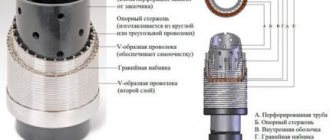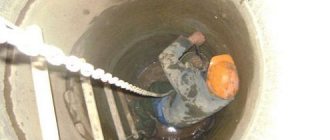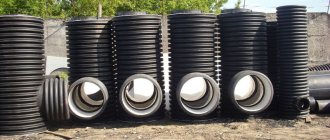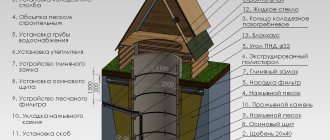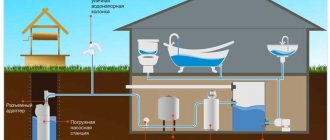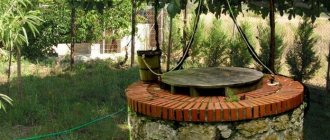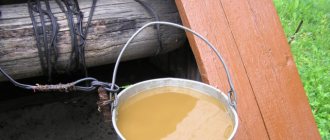Repairing a well is not difficult, the main thing is to do everything correctly and follow safety precautions
Have you noticed that the productivity of the well has weakened and there is not enough water for domestic needs? This means it’s time to clean and repair the water intake shaft. I'll tell you everything you need to know to restore your well, and at the end there's a video course waiting for you. As a result, you will be able to independently find the cause of the problem, eliminate it and return the previous water level in the well.
Signs of destruction
To maintain the source in good condition, the water quality should be regularly checked and the mine inspected. In this way, the reasons why it is necessary to repair it are determined. There may be several of them:
- drying out;
- water pollution;
- trunk destruction;
- violation of the waterproofing layer.
- The most common reason for repairing wells is when they dry up. That is, the depth is not sufficient to reach the surface of the aquifer. During restoration, the depth is increased by drilling a hole in the bottom or driving pipes to the water level.
- Pollution is caused by the appearance at the bottom of a sediment of small particles of sand and silt. To eliminate this problem, pump out water, clean and disinfect the bottom. If necessary, you should deepen the bottom of the source and install a filter to purify the water.
- Shedding of the trunk walls often occurs. This can occur due to the destruction of concrete rings and their displacement. Sewage and dirt penetrate inside. The cracks are repaired with cement, and the rings are securely attached to each other.
- Violation of the waterproofing layer leads to groundwater and wastewater entering the well. To eliminate this problem, the seams between the rings are putty and cracks in the walls of the barrel are sealed. The work is carried out from the outside, for which a repair trench should be dug. After the work is completed, the pit is filled with clay, which serves as an additional waterproofing material.
When is well repair required?
The first “bell” indicating that something is wrong with the well is a deterioration in water quality.
It acquires an unpleasant taste, smell, and becomes cloudy. It is not recommended to drink such water. And it is also unsuitable for household appliances and plumbing equipment: filter cartridges quickly “fly” and devices deteriorate. The reasons for the appearance of contamination in a well can be very different:
- A large amount of silty natural deposits on the walls and bottom of the mine, which are a mixture of organic microparticles, bacteria and unicellular algae. The organic mixture decomposes, which gives the water an unpleasant taste and odor.
- Large contaminants accidentally found in the mine. This could be an animal that fell into a well, or leaves, debris, etc. that fell into the water.
- Organic matter and soil particles entering the mine through a lining that has lost its tightness.
To prevent cloudiness of the water and other troubles, the well owner needs to carry out all repair work promptly and competently.
Through the joints of concrete rings that have lost their sealing, groundwater and wastewater seep into the well, which significantly deteriorates the quality of well water.
Well shaft repair activities are of two types:
- scheduled maintenance;
- unscheduled repair work.
The first ones are carried out regularly, after a certain period of time. Their goal is to maintain proper cleanliness in the well shaft and timely detection of minor damage that needs to be repaired immediately.
You must understand that any major breakdown or accident is always preceded by many minor faults. If you don't fight them, serious problems will arise.
During scheduled repair work, the filter is usually replaced or completely cleaned, deposits and build-ups are removed from the walls of the shaft, disinfection is carried out, minor defects and damage are eliminated, as well as water is pumped, which is necessary after repairs or long downtime.
Unscheduled repairs are carried out to eliminate major defects that appeared due to extraneous mechanical influences, improper operation, etc.
Maintenance of wooden
Both the above-ground part and the underground part, which is a wooden frame, are vulnerable.
In case of damage, the part of the structure located above the surface is not difficult to replace. It is carefully disassembled so that debris does not fall into the water, and reassembled. Sometimes damaged elements of the above-ground part are repaired using concrete mortar and formwork. To carry out the work, it is necessary to prepare the site.
- It is knocked down from boards in such a way that it fits freely into the shaft.
- They hang it on the beams using cables and get to work.
- We remove the old material from the damaged area of the head and formwork is made using reinforcing mesh.
- The result is a gap between the mesh and the barrel wall, which is filled with cement mortar.
Repair of the underground part of a wooden well begins with a routine inspection of its crowns. During operation, logs become rotten and must be replaced. In case of minor damage, they are cleaned and treated with protective material.
In some cases, they get by by replacing several logs of the log house. For this:
- pump out water if damaged logs are below its level;
- then it is necessary to strengthen the part of the wooden structure located above the damaged logs. This requires the construction of a special device. Large trestles are installed on the surface on both sides of the head. A log is laid on them, to which two long boards are attached. Their lower edge is lowered into the shaft and nailed to the crowns located above the part of the frame being replaced;
- long boards can be replaced with strong ropes with hooks. The main thing is that the whole part of the log house is suspended;
- After strengthening the structure, the damaged elements are removed and raised upward. Based on their shape and size, new parts of the log house are prepared. It is necessary that the new log fits into the grooves of the existing structure. It is placed in place and securely wedged.
Sometimes individual elements cast from concrete are used instead of new logs. This makes the structure more durable.
The work uses a wooden ladder of the required length or a rope ladder with a significant depth of the source. Complete replacement of the frame of an underground structure is a painstaking process and requires the installation of new crowns.
Well cleaning and disinfection
Quite often, a well simply needs to thoroughly clean the walls and bottom so that the water becomes clear and safe again. The appearance of biological deposits on concrete or wooden walls is a natural process that occurs in stagnant places. Debris that enters through the top opening begins to decompose, forming pockets of bacteria.
READ MORE: Samsung washing machine errors and repair tips
Well cleaning steps:
- pumping water using a pump;
- removing sludge from the bottom;
- installing a filter;
- cleaning walls with special compounds.
If the remains of dead animals are found at the bottom, the well must be disinfected. The simplest and most affordable option is “treatment” with chlorine. Pump in water, pour in a sufficient amount of chlorine solution, cover the top with a thick cloth (for example, a tarpaulin), and leave for a day. Then the chlorine water is pumped out and the well is completely washed.
Before cleaning the well, it is necessary to prepare devices for descent: a ladder, support rods, safety ropes or belts, wooden platforms on cables
One of the traditional compositions for cleaning the walls of a well is the familiar solution of potassium permanganate. It should be rich, dark in color
To clean a well at your dacha, you can purchase a ready-made composition, for example, a disinfectant stabilizing chlorine solution for swimming pools Chemoclor
How to repair a shaft made of concrete rings
Despite the strength of the material from which the source is made, there is often a need for its restoration.
The reason may be poor-quality installation of the structure and displacement of the rings under the influence of various factors. The result of mine destruction is pollution due to the ingress of wastewater and soil.
Repair work consists of sealing seams and cracks. The reason for their appearance may be destruction under the influence of moisture or displacement of the lower rings, for example, under the influence of quicksand.
The order of work is as follows:
- To choose the type of repair, you should determine to what extent the seam is damaged or how deep the crack is. This is done by tapping.
- When only the outer layer is shed, work is carried out from inside the source. Clean the inner surface of the collector. At the same time, all chipping parts of concrete are carefully removed. The holes that appear are carefully sealed with a high-quality solution.
- if the crack is through, work should be carried out both inside and outside the source. To do this, dig a shaft around the perimeter so that there is enough free space for repairs. The damage is well cleaned of dirt from the outside of the trunk and the crack is sealed with cement mortar. The repair area is covered with an additional waterproofing layer.
You can prevent the rings from shifting at the stage of their installation. To do this, the joints are additionally secured with metal brackets measuring 4 x 30 cm. At least 4 such plates are placed at each joint. The brackets are secured with bolts by drilling a hole in the concrete. This event will prevent the rings from moving relative to each other.
If the shift problem does occur, it must be eliminated. To do this, the trunk is dug up in a circle until the ring has moved. They put it in place and cement the joints on the outside and inside of the shaft. For greater reliability, metal staples are installed at the joints so that the rings no longer move.
If this method is not acceptable, a repair shaft is made from plastic pipes, the diameter of which is slightly smaller than the concrete rings. Elements of the plastic structure are lowered along the entire length of the shaft, connecting them using threads, and the space between the repair pipe and the rings is filled with sand or a cement-sand mixture.
Restoration is also carried out in more innovative ways. These include pneumatic repair of concrete surfaces using special protective and restoring compounds. These products significantly increase the resistance of concrete to mechanical damage. They also have other advantages:
- resistance to temperature changes;
- protection of fittings from corrosion;
- reliable waterproofing performance.
Before applying the composition, the surface is cleaned of dirt and moistened with water. The mixture is prepared immediately before work in strict accordance with the instructions. The roughness of the base promotes better adhesion of the material.
Plastic mine
Plastic rings for wells are increasingly being used. They are light in weight, highly durable and do not affect water quality.
- They are made from polypropylene or polyethylene.
- These materials are inert, which is why they are resistant to exposure to aggressive environments.
- They are used at temperatures from +50 °C to -70 °C.
- No additional costs are required for waterproofing, since the material is non-hygroscopic.
- When constructing a source, there is no need to use heavy equipment, which reduces the cost of work.
- Mounted using threaded connections. Since the rings are prefabricated, they can be installed to the required depth.
Plastic elements are used in the construction of sewer and drainage systems, as well as in the repair of existing water sources made of brick or concrete rings.
If the well is old, then work to replace its individual elements can lead to new damage and its complete destruction.
In this case, the best solution would be to use plastic rings to repair the shaft. With their help, you can repair an existing source and even restore an abandoned well from wood.
This material has a dense structure; the walls of the rings cope well with horizontal loads.
We carry out the audit ourselves
Under the influence of various factors and with regular use, the source, regardless of its type, may lose its performance. To prevent such a situation, maintenance work should be carried out.
First of all, this is carrying out audits and monitoring the condition of all structural elements, its preventive repairs and major replacement of individual elements.
The process consists of the following types of work:
- visual inspection;
- scheduled mine cleaning;
- preventive repairs and scheduled maintenance.
External inspection is carried out regularly and does not require any additional devices. The integrity of the head and shaft is visually assessed.
Carrying out preventive cleaning of the source depends on the material from which it is made, its depth and soil composition. This work should be carried out every six months. Although, with proper operation and normal condition of the aquifer, cleaning is carried out every four to five years.
Between such planned well maintenance activities, you need to constantly monitor the quality of drinking water in it. If factors appear that affect the condition of the source, it should be cleaned unscheduled. The reasons for this may be:
- violation of the tightness of the seams between the shaft elements. As a result of such destruction, unfiltered groundwater may enter the well;
- ingress of dirt from the surface into the source. Occurs in the event of destruction of the above-ground part of the well;
- accumulation of sediment and silt at the bottom. This leads to a gradual restriction of clean water entering the mine;
- bacterial and chemical contamination.
Particular care should be taken when inspecting the well in the spring, after the passage of floods and thawing of snow. In winter, mines are subject to additional stress. Freezing of the soil leads to its swelling, which can lead to damage to the joints between structural elements.
Causes of well contamination
If the water has acquired an unpleasant odor and has become cloudy, there are several explanations for this.
Causes:
- The bottom was silted. Structures located on quicksand are especially affected by silt.
- The bottom may also rise due to pumping out water.
- If plants/animals get inside.
- Oil ingress from the pump also causes the bottom to rise.
- If the structure of the clay castle is damaged, then clay soil can penetrate inside.
- Also, the quality of water may deteriorate due to the fact that the seams were sealed incorrectly during the construction phase.
- Contamination of the filtration device, which is located at the very bottom, also contributes to the deterioration of water quality.
In most cases, during cleaning, flaws and cracks are found that need repair. Before repairing a well made of concrete rings, it is worth finding out in what cases it is necessary
The appearance of cloudy and contaminated water in a well is possible for various reasons. The most common of them are:
- The bottom of the structure has risen or been covered with silt. The phenomenon is very common when constructing a well on quicksand. Also, the rise of the bottom is provoked by excessive pumping of water, which activates the process of sand washing.
- Artificial pollution of the structure. It becomes the result of an accidental entry of an animal or plant into the well, as well as oil leakage from the pump.
- Clay falling into a well. This happens due to a violation of the integrity of the clay castle built around the structure.
- Poor sealing of seams or absence or contamination of the bottom filter, which leads to the appearance of cloudy water.
- Reducing the water level in the well.
The bottom of the well, covered with silt, must be cleaned, otherwise the water from it will no longer please with its original purity
Quite often, in a well that has recently regularly supplied clean water, the liquid acquires an unpleasant taste and smell, and it becomes colored, indicating the presence of foreign impurities. Such water cannot be used for drinking or culinary purposes. In addition, an increased amount of impurities can damage plumbing fixtures and household appliances, and quickly render filter cartridges unusable.
- Natural silt deposits on the walls and bottom of the canal, which are a mixture of unicellular algae, microparticles of organic matter, bacteria, etc. that have entered the water. Like any organic matter, such a mixture begins to decompose, giving the water an unpleasant odor and taste.
- Large contaminants accidentally falling into the well - leaves blown by the wind through the upper part that is not closed with a lid, small animals that have fallen and drowned, etc.
- Soil particles and organic matter from the soil entering through the walls when their tightness is broken.
If in the first two cases you can limit yourself to cleaning and sanitizing the structure, in the latter you will have to think about how to repair the well.
For repair work, you will probably need a rope ladder for the well. Read how to make it yourself in our separate article.
Regular cleaning of the well is the key to its long functioning and the presence of water in it without impurities and contaminants. There is information on how to do it here.
Insufficient water levels can make it difficult to lift liquid to the surface, whether this operation is performed manually or using pumping equipment. There are two reasons for the decrease in level:
- incorrectly selected source location,
- insufficient mine depth.
In the first case, most likely, the error will be noticeable immediately, and the only solution will be to move the well to a new location.
Before moving the well, you can try increasing its depth.
- If the structure is no more than six months old, the structure can be lowered by removing soil from under the lower part of the structure. Excavation work should be carried out until a sufficient number of keys appear. After the well settles, its upper part is increased to the required height.
- Repairing an old well with your own hands when the water level drops is carried out in a similar way, but it is necessary to narrow the structure (use concrete rings of a smaller diameter, change the parameters of the brickwork, etc.).
Before starting repair or cleaning work, find out what the problem is. Particles of substances foreign to water are deposited daily on the walls of concrete rings. They get there during operation both from containers lowered under the water intake and through an open hatch. If the frequency of cleaning the well is not observed, the water becomes contaminated with bacteria, organic matter and mechanical particles.
Repair of wells is carried out even if there are cracks between the rings, as well as a violation of the plane of the tunnel. In case of damage of this kind, water deteriorates in its quality due to the ingress of dirt and ground moisture. It is not uncommon for rodents and other animals to enter a well pool. Their presence there, especially their death, causes water pollution. Of all the factors, this is the most unpleasant. In addition to the cleaning process, disinfection is carried out.
Do-it-yourself well repair is completely interconnected with its cleaning. These things require consistency in one direction and the other. After repairs, cleaning measures are carried out, and before technical work in the structure, cleaning is carried out.
Deposits on the walls of the well must be cleaned regularly
READ MORE: How to make a bunk bed with your own hands
| Illustrations | Causes of water pollution |
| Depressurization of seams. This problem is relevant for both concrete and brick wells. In reinforced concrete structures, the tightness is lost along the line where the rings adjoin each other. In brick buildings, the tightness of the seam between bricks is reduced. When the seams are depressurized, water mixes with the soil from the walls of the pit and becomes contaminated. The degree of pollution increases with the beginning of snow melting, when the groundwater level rises. Solution to the problem: complete restoration of the seam tightness and additional waterproofing of the joints. | |
| Penetration of debris into the mine from the outside. Symptoms: putrid taste and cloudy water. Solution to the problem: complete cleaning of the shaft, construction of a canopy and installation of a cover. | |
| Silting of the bottom and walls of the mine. Symptoms: cloudiness and marshy taste of water. Solution to the problem: cleaning the walls and bottom of the shaft from layers of silt, disinfection, updating the bottom filter. | |
| Rusty water. Symptoms: metallic taste and cloudy water. The problem is caused by excess iron content in groundwater. Solution to the problem: order a water treatment system (water deferrization) for installation in your home water supply. |
Why does the water disappear from the well? There are several reasons, including:
- They drilled a well in a neighboring area, did not plug the water carrier, and the water went away. The water level will not recover and you just have to dig a well in another place, and perhaps you will end up in another aquifer.
- Lowering groundwater levels. This trend is observed from time to time in relation to a particular region. There is only one solution to the problem - deepening the mine by at least 5 meters.
Safety equipment for potentially hazardous work is required!


